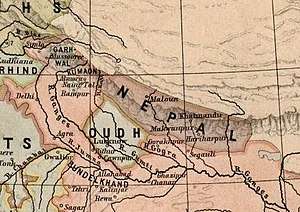Treaty of Sugauli
The Treaty of Sugauli (also spelled Sugowlee, Sagauli, Soogoulee), the treaty that established the boundary line of Nepal, was signed on 2 December 1815 and ratified by 4 March 1816 between the East India Company and Raj Guru Gajaraj Mishra with Chandra Shekhar Upadhaya for Nepal following the Anglo-Nepalese War of 1814-16. The treaty represented a Nepali surrender to the British and contained the cession of Nepal's western territory to the British East India Company.[1][2]
 | |
| Drafted | December 2, 1815 |
|---|---|
| Signed | March 4, 1816 |
| Location | Sugauli, India |
| Signatories | Parish Bradshaw (for the Company Government) and Raj Guru Gajaraj Mishra with Chandra Shekhar Upadhaya (for Nepal) |
| Parties | |
| Ratifiers | Governor-General David Ochterlony (British India) |
| Language | English |


Background
Following the Unification of Nepal under Prithvi Narayan Shah, Nepal attempted to enlarge its domains, conquering much of Sikkim in the east and, in the west, the basins of Gandaki and Karnali and the Uttarakhand regions of Garhwal and Kumaon. This brought them in conflict with the British, who controlled directly or indirectly the north Indian plains between Delhi and Calcutta. A series of campaigns termed the Anglo-Nepalese War occurred in 1814–1816. In 1815 the British general Ochterlony evicted the Nepalese from Garhwal and Kumaon across the Kali River,[3][4] ending their 12-year occupation, which is remembered for its brutality and repression.[5][6]
Octherlony offered peace terms to the Nepalese demanding British suzerainty in the form of a protected state and the delimitation of Nepal's territories corresponding roughly to its present day boundaries. The Nepalese refusal to accede to the terms led to another campaign the following year, targeting the Kathmandu Valley, after which the Nepalese capitulated.[7][8]
Terms
Historian John Whelpton writes:
Negotiations for a general settlement produced a draft which was initialled at Sagauli in Bihar in December 1815 and required Nepal to give up all territories west and east of its present-day borders, to surrender the entire Tarai and to accept a permanent British representative (or 'resident') in Kathmandu. The Nepalese government initially balked at these terms, but agreed to ratify them in March 1816 after Ochterloney occupied the Makwanpur Valley only thirty miles from the capital.[9]
Ongoing disputes
Among the border dispute of the Indo-Nepal boundary, the most significant are in the Susta and Kalapani regions.[10] The two regions cover some 40 km of the Indo-Nepal border.
See also
- Gurkha War
- 1950 Indo-Nepal Treaty of Peace and Friendship
- Sikkim
- Kingdom of Nepal
- Unification of Nepal
- Prithvi Narayan Shah
References
- "Original copies of both Sugauli Treaty and Nepal-India Friendship Treaty are missing". kathmandupost.com. Retrieved 27 May 2020.
- "Treaty of Sagauli | British-Nepalese history [1816]". Encyclopedia Britannica. Retrieved 27 May 2020.
- Whelpton, A History of Nepal (2005), p. 41-42.
- Rose, Nepal – Strategy for Survival (1971), pp. 83–85: "Ochterlony forced Amar Singh Thapa to agree at Malaun to terms under which the Nepali army retired with their arms, and the territory between the Kali and Sutlej rivers came under the control of the British."
- Whelpton, A History of Nepal (2005), p. 58.
- Oakley, E. Sherman (1905), Holy Himalaya: The Religion, Traditions, and Scenery of a Himalayan Province (Kumaon and Garhwal), Oliphant Anderson & Ferrier, pp. 124–125 – via archive.org
- Whelpton, A History of Nepal (2005), p. 41-42: "The Nepalese government initially balked at these terms, but agreed to ratify them in March 1816 after Ochterloney occupied the Makwanpur Valley only thirty miles from the capital."
- Rose, Nepal – Strategy for Survival (1971), pp. 87–88: "[In 1816] With the collapse of the main defense line, the Darbar quickly dispatched Chandra Sekhar Upadhyaya to Ochterlony's camp with a copy of the Sugauli treaty bearing the seal of the Maharaja."
- Whelpton, A History of Nepal (2005), p. 42.
- Stephen Groves (22 September 2014). "India and Nepal Tackle Border Disputes". The Diplomat. Archived from the original on 29 March 2017. Retrieved 28 March 2017.
Bibliography
- Atkinson, Edwin Thomas (1981) [first published 1884], The Himalayan Gazetteer, Volume 2, Part 2, Cosmo Publications – via archive.org
- Atkinson, Edwin Thomas (1981) [first published 1884], The Himalayan Gazetteer, Volume 3, Part 2, Cosmo Publications – via archive.org
- Chatterjee, Bishwa B. (January 1976), "The Bhotias of Uttarakhand", India International Centre Quarterly, 3 (1): 3–16, JSTOR 23001864
- Cowan, Sam (2015), The Indian checkposts, Lipu Lekh, and Kalapani, School of Oriental and African Studies
- Dhungel, Dwarika Nath; Pun, Santa Bahadur (2014), "Nepal-India Relations: Territorial/Border Issue with Specific Reference to Mahakali River", FPRC Journal, New Delhi: Foreign Policy Research Centre – via academia.edu
- Manandhar, Mangal Siddhi; Koirala, Hriday Lal (June 2001), "Nepal-India Boundary Issue: River Kali as International Boundary", Tribhuvan University Journal, 23 (1)
- Rose, Leo E. (1971), Nepal – Strategy for Survival, University of California Press, ISBN 978-0-520-01643-9
- Rose, Leo E. (January–February 1999), "Nepal and Bhutan in 1998: Two Himalayan Kingdoms", Asian Survey, 39 (1): 155–162, JSTOR 2645605
- Schrader, Heiko (1988), Trading Patterns in the Nepal Himalayas, Bow Historical Books, ISBN 978-3-88156-405-2
- Shrestha, Buddhi N. (2013), "Demarcation of the International Boundaries of Nepal", in Haim Srebro (ed.), International Boundary Making (PDF), Copenhagen: International Federation of Surveyors, pp. 149–182, ISBN 978-87-92853-08-0
- Upadhya, Sanjay (2012), Nepal and the Geo-Strategic Rivalry between China and India, Routledge, ISBN 978-1-136-33550-1
- Walton, H. G., ed. (1911), Almora: A Gazetteer, District Gazetteers of the United Provinces of Agra and Oudh, 35, Government Press, United Provinces – via archive.org
- Whelpton, John (2005), A History of Nepal, Cambridge University Press, ISBN 978-0-521-80470-7
| Wikisource has original text related to this article: |
External links
| Wikimedia Commons has media related to Treaty of Sugauli. |